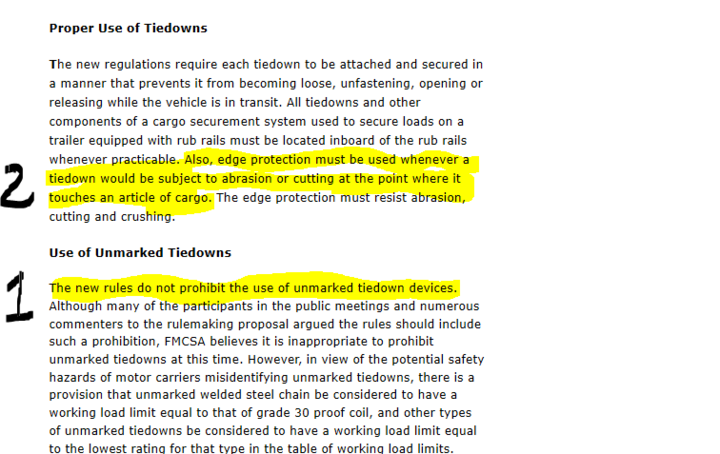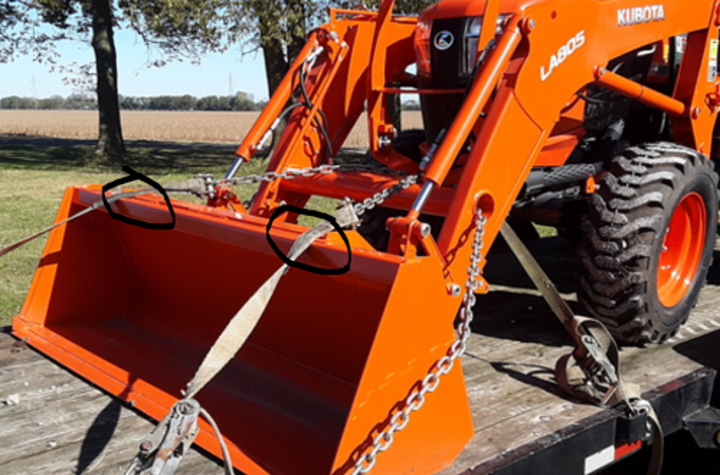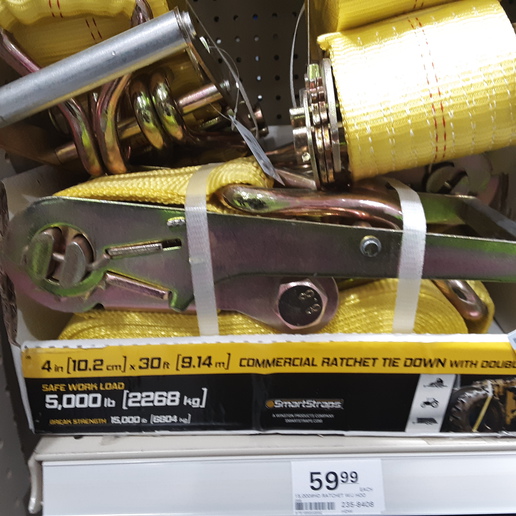You should upgrade or use an alternative browser.
- Thread starter Geo-TH,In
- Start date
Russ from MN
Well-known Member
- Location
- Bemidji MN
Adirondack case guy
Well-known Member
Use chains on your farm and construction equipment and the straps on boards and the old refrigerator that you are taking to the scrapper.------------Loren
Geo-TH,In
Well-known Member
Some might go onto cardiac arrest when I say I'll be looking for DOT straps for Hota (Kobota's name).
I already have G70 chains.
When I find the sweet spot to park Hota with loader on the trailer I'll make chains long enough to stop her at the sweet spot. May need different length for Hota without loader and with mower.
Geo-TH,In
Well-known Member
George
john in la
Well-known Member
HUH.
What is that suppose to mean???
While straps are legal Loren gave you some good reasons not to use straps.
Some could get you a ticket.
If you want to use straps at least look for the straps with a short piece of chain on each end.
By the way....
Unmarked 4 inch straps are good for 4000 lbs no matter what the box says.
fixerupper
Well-known Member
Ultradog MN
Well-known Member
- Location
- Twin Cities
john in la
Well-known Member
See point number 1 in the picture below.

But to tell you the truth it becomes pointless and frustrating to post DOT rules on this site.
Take the post below from Loran.
He gave you good reasons not to use straps.
Your response was I use 8 tie downs.
I do this I do that.
You fail to see the point made trying to defend what you feel is right.
So I will show it to you in pictures.
Read point 2.
Now look at your picture with your 8 tie downs.
Do you now see the two abrasion points.
That is considered a ticket able offence by the DOT.

caterpillar guy
Well-known Member
These are the current regs per FMCSA website for tiedown ratings and how it's done.
?393.108 How is the working load limit of a tiedown, or the load restraining value of a friction mat, determined?
(a) The working load limit (WLL) of a tiedown, associated connector or attachment mechanism is the lowest working load limit of any of its components (including tensioner), or the working load limit of the anchor points to which it is attached, whichever is less.
(b) The working load limits of tiedowns may be determined by using either the tiedown manufacturer's markings or by using the tables in this section. The working load limits listed in the tables are to be used when the tiedown material is not marked by the manufacturer with the working load limit. Tiedown materials which are marked by the manufacturer with working load limits that differ from the tables, shall be considered to have a working load limit equal to the value for which they are marked.
(c) Synthetic cordage (e.g., nylon, polypropylene, polyester) which is not marked or labeled to enable identification of its composition or working load limit shall be considered to have a working load limit equal to that for polypropylene fiber rope.
(d) Welded steel chain which is not marked or labeled to enable identification of its grade or working load limit shall be considered to have a working load limit equal to that for grade 30 proof coil chain.
(e)(1) Wire rope which is not marked by the manufacturer with a working load limit shall be considered to have a working load limit equal to one-fourth of the nominal strength listed in the Wire Rope Users Manual.
(2) Wire which is not marked or labeled to enable identification of its construction type shall be considered to have a working load limit equal to that for 6 ? 37, fiber core wire rope.
(f) Manila rope which is not marked by the manufacturer with a working load limit shall be considered to have a working load limit based on its diameter as provided in the tables of working load limits.
(g) Friction mats which are not marked or rated by the manufacturer shall be considered to provide resistance to horizontal movement equal to 50 percent of the weight placed on the mat.
Tables to ?393.108
[Working Load Limits (WLL), Chain]
Size mm (inches) WLL in kg (pounds)
Grade 30 proof coil Grade 43 high test Grade 70 transport Grade 80 alloy Grade 100 alloy
1. 7 (1/4) 580 (1,300) 1,180 (2,600) 1,430 (3,150) 1,570 (3,500) 1,950 (4,300)
2. 8 (5/16) 860 (1,900) 1,770 (3,900) 2,130 (4,700) 2,000 (4,500) 2,600 (5,700)
3. 10 (3/8) 1,200 (2,650) 2,450 (5,400) 2,990 (6,600) 3,200 (7,100) 4,000 (8,800)
4. 11 (7/16) 1,680 (3,700) 3,270 (7,200) 3,970 (8,750)
5. 13 (1/2) 2,030 (4,500) 4,170 (9,200) 5,130 (11,300) 5,400 (12,000) 6,800 (15,000)
6. 16 (5/8) 3,130 (6,900) 5,910 (13,000) 7,170 (15,800) 8,200 (18,100) 10,300 (22,600)
Chain Mark Examples:
Example 1 3 4 7 8 10
Example 2 30 43 70 80 100
Example 3 300 430 700 800 1000
Synthetic Webbing
Width mm (inches) WLL kg (pounds)
45 (13⁄4 ) 790 (1,750)
50 (2) 910 (2,000)
75 (3) 1,360 (3,000)
100 (4) 1,810 (4,000)
Wire Rope (6 ? 37, Fiber Core)
Diameter mm (inches) WLL kg (pounds)
7 (1/4) 640 (1,400)
8 (5/16) 950 (2,100)
10 (3/8) 1,360 (3,000)
11 (7/16) 1,860 (4,100)
13 (1/2) 2,400 (5,300)
16 (5/8) 3,770 (8,300)
20 (3/4) 4,940 (10,900)
22 (7/8) 7,300 (16,100)
25 (1) 9,480 (20,900)
Manila Rope
Diameter mm (inches) WLL kg (pounds)
10 (3/8) 90 (205)
11 (7/16) 120 (265)
13 (1/2) 150 (315)
16 (5/8) 210 (465)
20 (3/4) 290 (640)
25 (1) 480 (1,050)
Polypropylene Fiber Rope WLL (3-Strand and 8-Strand Constructions)
Diameter mm (inches) WLL kg (pounds)
10 (3/8) 180 (400)
11 (7/16) 240 (525)
13 (1/2) 280 (625)
16 (5/8) 420 (925)
20 (3/4) 580 (1,275)
25 (1) 950 (2,100)
Polyester Fiber Rope WLL (3-Strand and 8-Strand Constructions)
Diameter mm (inches) WLL kg (pounds)
10 (3/8) 250 (555)
11 (7/16) 340 (750)
13 (1/2) 440 (960)
16 (5/8) 680 (1,500)
20 (3/4) 850 (1,880)
25 (1) 1,500 (3,300)
Nylon Rope
Diameter mm (inches) WLL kg (pounds)
10 (3/8) 130 (278)
11 (7/16) 190 (410)
13 (1/2) 240 (525)
16 (5/8) 420 (935)
20 (3/4) 640 (1,420)
25 (1) 1,140 (2,520)
Double Braided Nylon Rope
Diameter mm (inches) WLL kg (pounds)
10 (3/8) 150 (336)
11 (7/16) 230 (502)
13 (1/2) 300 (655)
16 (5/8) 510 (1,130)
20 (3/4) 830 (1,840)
25 (1) 1,470 (3,250)
Steel Strapping
Width ? thickness mm (inches) WLL kg (pounds)
31.7 ? .74 (11⁄4 ? 0.029) 540 (1,190)
31.7 ? .79 (11⁄4 ? 0.031) 540 (1,190)
31.7 ? .89 (11⁄4 ? 0.035) 540 (1,190)
31.7 ? 1.12 (11⁄4 ? 0.044) 770 (1,690)
31.7 ? 1.27 (11⁄4 ? 0.05) 770 (1,690)
31.7 ? 1.5 (11⁄4 ? 0.057) 870 (1,925)
50.8 ? 1.12 (2 ? 0.044) 1,200 (2,650)
50.8 ? 1.27 (2 ? 0.05) 1,200 (2,650)
Adirondack case guy
Well-known Member
Loren
john in la
Well-known Member
The tractor needs to be tied down.
Then any attachments need to be tied down ie loader and brush cutter.
So you would tie the tractor down with 4 chains and then need 1 chain across the loader bucket and 1 chain across the brush cutter.
Similar threads
- Replies
- 17
- Views
- 1K
We sell tractor parts! We have the parts you need to repair your tractor - the right parts. Our low prices and years of research make us your best choice when you need parts. Shop Online Today.
Copyright © 1997-2024 Yesterday's Tractor Co.
All Rights Reserved. Reproduction of any part of this website, including design and content, without written permission is strictly prohibited. Trade Marks and Trade Names contained and used in this Website are those of others, and are used in this Website in a descriptive sense to refer to the products of others. Use of this Web site constitutes acceptance of our User Agreement and Privacy Policy TRADEMARK DISCLAIMER: Tradenames and Trademarks referred to within Yesterday's Tractor Co. products and within the Yesterday's Tractor Co. websites are the property of their respective trademark holders. None of these trademark holders are affiliated with Yesterday's Tractor Co., our products, or our website nor are we sponsored by them. John Deere and its logos are the registered trademarks of the John Deere Corporation. Agco, Agco Allis, White, Massey Ferguson and their logos are the registered trademarks of AGCO Corporation. Case, Case-IH, Farmall, International Harvester, New Holland and their logos are registered trademarks of CNH Global N.V.
Yesterday's Tractors - Antique Tractor Headquarters
Website Accessibility Policy


